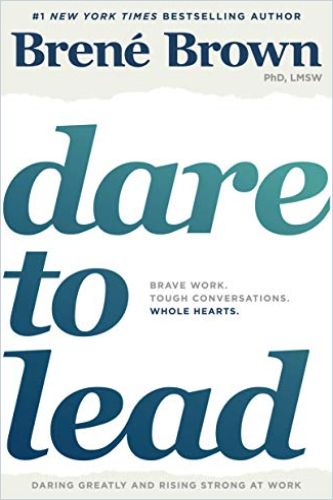In Dare to Lead, bestseller Brené Brown supplements her Daring Greatly and Rising Strong with exercises and insights specifically for leaders.

Don’t Be Afraid to Lead
Vulnerability researcher and TED superstar Brené Brown supplements her New York Times bestsellers, Daring Greatly and Rising Strong, with new research in Dare to Lead, which covers personal experiences, case studies and data from interviews with top leaders. She issues a call to lead bravely and foster courageous workplace cultures. Brown explains that, in contrast to “armored” leaders who act from a stance of self-protection and self-interest, daring leadership comes from a place of courage, heart and confidence.
She offers practical guidelines and a process for applying the lessons of her previous books to your leadership practice. Her process can be arduous: you must commit to looking within yourself and initiating tough conversations with your colleagues and co-workers. However, Brown stresses that you can learn the skills and behaviors of daring leadership at any point in your career.
The skill sets that make up courage are not new; they’ve been aspirational leadership skills for as long as there have been leaders. Yet we haven’t made great progress in developing these skills in leaders, because we don’t dig into the humanity of this work – it’s too messy.Brené Brown
Bloomberg named this New York Times number one bestseller among its best books of the year. Sheryl Sandberg, Facebook CEO, said, “Brené brings decades of research to bear in a practical and insightful guide to courageous leadership.” Ed Catmull, president of Pixar and Walt Disney Animation Studios, agreed: “You don’t achieve good culture without constant attention, without an environment of safety, courage and vulnerability. These are hard skills, but they are teachable skills. Start with this book.”
Courage and Fear
Brown identifies a common misconception: that courage and fear are mutually exclusive. With typical compassion and insight, she reminds you that most people experience fear even while they act courageously.
Brown calls out leadership and organizational behaviors that thwart productivity, innovation and advancement. These behaviors include avoiding tough conversations, spending too much time managing problems instead of working proactively toward solutions, avoiding risk, and failing to build relationships or show empathy. Problems include shaming and blaming, setting corporate values that are aspirational rather than practical, and being reluctant to address diversity and inclusion.
“Rumbling with Vulnerability”
Brown reminds leaders that failure and pain are part of growth. Stepping into the arena and taking on a challenge when the outcome is uncertain exemplifies vulnerability – not a weakness, but a show of strength.
The courage to be vulnerable is not about winning or losing; it’s about the courage to show up when you can’t predict or control the outcome.Brené Brown
Brown illustrates the use of a rumble by offering up her own mistakes as examples. In the early days of her company, her team asked for a “rumble.” Charles, the CFO, pointed out that Brown continually set unrealistic timelines which created stress for her employees. The message was hard for Brown to hear, but she appreciated Charles’s honesty.
Brown is adamant that you should choose – and listen to – a few people whose feedback you value and respect. She makes clear that the belief that you can “go it alone” is a myth. Brave leaders’ candor about their struggles gives others permission to be honest about their feelings.
“Armored Leadership”
Brown asserts that leaders who don’t shed the armor of self-protection spend their energies managing unproductive behavior. She identifies the enemy of wholeheartedness as ego, which craves validation and attention. Recognizing and coping with shame – and replacing it with fortitude – is Brown’s best-selling metiér.
What would it look like to combine courage, connection and meaning with the world of work?Brené Brown
In contrast to self-protection, she says, daring leadership includes striving for excellence rather than demanding perfection, recognizing and celebrating accomplishments, and developing strategies to manage anxiety and renew the spirit.
“Living …Values”
Brown strives to live her values, and she monitors her behavior to make sure she succeeds. She suggests that you identify the two values that most define your belief system and position them as your behavioral North Star. With your core values as a positive guide, you can choose what’s right instead of what’s expedient.
“Braving Trust”
Brown loves creating acronyms. Her acronym “BRAVING,” however awkward, represents seven behaviors that combine to build trust: “Boundaries, Reliability, Accountability, Vault – keep others’ confidences as if you put them in a vault – Integrity, being Nonjudgmental and Generosity.”
“Learning to Rise”
Brown says that gaining skills in rising up enables people to take risks and leap into the vast unknown. When you react emotionally to something, she urges, move forward based on your feelings by becoming curious about what you feel and why. Tune in to your mind and body’s reactions, such as an increased heartbeat, dry mouth or scattered thoughts.
A Familiar, Worthy Voice
Brown excels at reminding you that the internal contradictions you may wish you could disavow are fundamental to human nature and should not be a source of shame. As she pointed out in the TED talk that made her brand, shame is a universal human emotion, even though it’s often taboo. She cites empathy and self-care as antidotes to shame.
When our organization rewards armoring behaviors like blaming, shaming, cynicism, perfectionism and emotional stoicism, we can’t expect innovative work. You can’t fully grow and contribute behind armor.Brené Brown
Brown creates terminology that is new but that seems familiar and apt on first reading. Her followers will get more of what they love from this business manual, even though much of it may be familiar from previous readings. Brown aims these pages at leaders of organizations, small businesses and teams who want to get to the heart of brave leadership.
Brown’s previous books aren’t directed to particular target audiences, though they offer applicable lessons. Here Brown’s advice for leaders seems hard-won, entirely personal and germane to most work situations. Her compassion is her singular gift. This manual provides an excellent starting place for any leader or would-be leader who is unfamiliar with Brown’s work. She covers all her usual touchstones and adds guidance specific to business.
Worthy ancillary books by Brown include her bestsellers Daring Greatly, The Gifts of Imperfection, Rising Strong and Braving the Wilderness.




